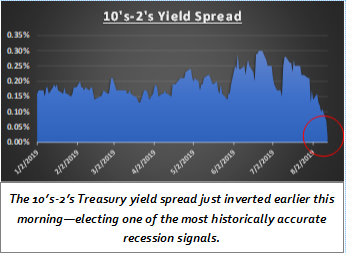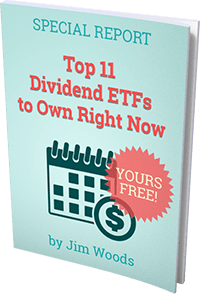Stocks are getting hit hard, and on Wednesday, the major averages were down big.
At one point in the session, the Dow was down more than 700 points. Interestingly, just one day before, stocks were up huge on some much-needed improvement on the United States-China trade front.
So, why did stocks dive after the positive trade news yesterday? The answer is simple: a yield curve inversion.
Earlier this morning, the yield on the 10-year Treasury note fell below the yield on the two-year Treasury (a.k.a. the 10s-2s yield spread). This foreboding economic signal is no joke, and it must be taken seriously, as the inversion in the yield curve has accurately predicted the last five recessions.

Chart courtesy of Sevens Report Research
I have been writing about the yield curve and the likelihood of an inversion in the 10s-2s spread in my Successful Investing and Intelligence Report advisory services over the past year or so, as the fear of an inverted planet (i.e. a world where you get more yield for a short-term loan than you do for taking on the risk of a longer-term loan) is a blaring warning beacon that global growth is about to get ugly.
The bigger fear here, is over recession, as historically a yield curve inversion in the 10s-2s precedes an official recession in the economy, although we don’t usually see it in the data for at least six months or more.
“Recessions are, honestly, arbitrary periods of time that are determined by the National Bureau of Economic Analysis long after the recession has started and, in some cases, ended,” said Tom Essaye of the Sevens Report. As veteran readers of my work will recognize, Tom is my friend and go-to macro analyst. He also happens to be one of the best in the business.
Tom told me that to keep in mind that recessions are backward-looking events, so rather than looking backward, we should be looking forward. And when it comes to looking forward for stocks, its important to keep in mind that the last three times the 10s-2s yield curve inverted, stocks peaked some six to 18 months later.
“While the inversion is certainly a disconcerting signal over the medium and longer term, it’s not a signal to necessarily sell stocks right now, because a lot can happen between now and six months or more,” said Essaye.
True enough, although I know it can be hard to see stocks down nearly 3.0% across the board in a single session, not to mention the sea of red you are likely looking at on your computer screens when you check your portfolios.
Finally, it has become fashionable these days for some pundits to claim that the inverted yield curve is something not to worry about. In fact, just this morning I heard a pundit on financial news TV say, “This is not your father’s yield curve.”
The implication here is “this time it’s different,” and that there isn’t anything to really worry about because the reasons for past yield curve inversions (the Federal Reserve taking money out of the system and driving rates on the short end higher) are not the same as the reason for this yield curve inversion (expectations of the Fed cutting rates on the short end over the course of the year).
Perhaps the most troubling thing here, in the fear of an inverted planet and the thing that is really causing the decline in the 10-year Treasury yield, is the fact that interest rates around the world are so low and in many cases, they are negative. That means you buy a 10-year bond from many countries in Europe or Japan, and you must pay them for the privilege of loaning the money. Stated differently, that means you don’t get any interest, you have to pay them for the privilege of holding your money for 10 years. So, even though the 10-year Treasury note is paying just under 1.6% here, 1.6% is better than paying someone 0.6% to hold your money for you — and that is what’s driving money into U.S. Treasury bonds, and driving the yield on those bonds lower (remember, bond prices are inverse to bond yields).
Yes, it’s an inverted, upside down world, but it’s the one we must navigate properly if we are going to make our money work for us. And that is what this publication, as well as my newsletter advisory services, help readers do each week.
*******************************************************************
Upside Down Wisdom
“The world is wrong side up. It needs to be turned upside down in order to be right side up.”
— Billy Sunday
The world often seems like it could use a good turn upside down. And while we can’t turn the whole world around by ourselves, we can turn our world around by looking at it from a different vantage point. So, the next time you’re facing a difficult problem that you’re struggling to solve, try changing your perspective. It might not give you the answer, but it certainly will help you look at the question in a new, and perhaps more illuminating, way.
Wisdom about money, investing and life can be found anywhere. If you have a good quote that you’d like me to share with your fellow readers, send it to me, along with any comments, questions and suggestions you have about my newsletters, seminars or anything else. Click here to ask Jim.
In the name of the best within us,


Jim Woods

![[U.S. Treasury Building]](https://www.stockinvestor.com/wp-content/uploads/3379315939_7f7ede8723_b.jpg)

![[instant messaging via tablets and phones]](https://www.stockinvestor.com/wp-content/uploads/shutterstock_125411345.jpg)
